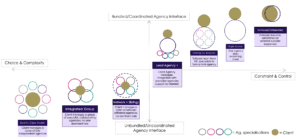Digital Marketing Transformation and the agency model
Digital Marketing Transformation changes the way we work and the way brands partner with agencies. We outline the journey that many brands are now embarked on.
However, you manage your agency roster, digital has meant big changes. Changes in the way consumers experience your brand. Changes in the types and frequency of communication. Changes in the tools and techniques to deliver your communications. Changes in the number and types of agencies you work with. And changes to the way you manage them.
Ultimately, it should also lead to changes in internal processes, governance of the agency model and ways of working that, in turn, could mean further changes to those relationships. It’s a multi-stage journey. How that journey affects each client will be different, dependent on what kind of agency model they currently have – and wish to have.
In our observations of agency models, we have identified seven basic types of agency model used by brands, although often a hybrid between some of the models is used. What determines the adoption of any particular agency model type is the business and communications strategy – and therefore changes in strategy to accommodate digital naturally imply an evolution or change to the agency model.
One key set of variables that might determine the agency model are around the level of choice and complexity in the roster model vs the level of control and constraint of their decisions and the level of co-ordination required by the client team to manage the agency interface.

At one end of the spectrum are those brands with a series of best-in-class roster agencies, a complex arrangement requiring a lot of effort from the marketer to ensure co-ordination and at the other are those with a full-service partner, although this is now a very rare occurrence. In between these options are arrangements such as lead agency models, integrated groups and network or Holding Company affiliations.
Challenged by the arrival of digital and social communications, many brands have hired specialist agencies to help them manage all these new channels. The brand needs to be everywhere and requires an agency to help with each channel, is how the thinking goes.
Thus, the agency model becomes bloated – resulting in increased complexity and cost to manage the expanded roster – as well as reduced effectiveness and efficiency in communications. Too many agencies requiring too much management for most marketing teams. Too much duplication and paying for the same services (multiple strategists and account managers) also means that working spend is reduced and internal time for addressing brand challenges is cut. Inefficiency rises.
At this stage, brands hopefully recognise the need to start taking back control. They realise that knowing more about the customer journey and better insights will help them manage the new world. Better measurement and clearer actionable data helps them identify their consumer’s real needs rather than responding to what the brand thinks they need.
Marketers with this insight are in a better position to know which channels are most critical and need ongoing support versus those which are only occasional needs. They can start to stand down some of their outside experts, possibly putting them on to a project basis.
This allows them to not just cut down the complexity but also to improve their level of co-ordination, whatever agency model they have, simply because they are clearer about what matters and there are fewer players in the mix.
Advertisers who have reached this point have a greater control of their strategy, which is applied more consistently and coherently across their communications, with better results.
The ideal destination, whatever roster model is adopted, is to get to a point where agencies are seen as true business partners, proposing channel neutral communications solutions based on a real understanding of the customer journey. Data and insights are shared more freely, while ad tech and marketing technology are adding effectiveness and efficiency rather than stress and salami slicing of budgets.
Making this new model work, however, requires advertisers and marketing organisations to closely examine the processes and governance they use to manage and work with their agencies.
It’s not enough to have the right model for your business, completing the journey also means having comprehensive measurement, optimisation and learning strategies in place. Even the right roster model won’t work without robust processes and governance that define who does what and how it is managed. This can often be the hardest part of the journey but it’s essential to keep the momentum.
Those that persist, however, get significant benefits. Not just better co-ordination and integration of messaging and communications but also higher quality and efficiency, reduced roster “bloat” and more focused use of resources.
The completed journey builds new skills and capabilities – both within brands and agencies and ensures both are ‘fit-for-purpose’ to meet the communications needs of their consumers.















